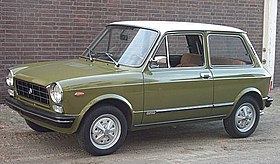Autobianchi A112
| Autobianchi A112 | |
|---|---|
 |
|
| Overview | |
| Manufacturer | Autobianchi |
| Also called | Lancia A112 |
| Production | 1969–1986 |
| Designer | Marcello Gandini at Bertone |
| Body and chassis | |
| Class | Supermini (B) |
| Body style | 3-door hatchback |
| Related | Fiat 127 |
| Powertrain | |
| Engine | |
| Transmission | 4-speed manual 5-speed manual |
| Dimensions | |
| Wheelbase | 2,038 mm (80.2 in) |
| Length | 3,230 mm (127.2 in) |
| Width | 1,480 mm (58.3 in) |
| Curb weight | 670 kg (1,477 lb) |
| Chronology | |
| Successor | Autobianchi Y10 |
The Autobianchi A112 is a supermini produced by the Italian automaker Autobianchi. It was developed using a shrunken version of the contemporary Fiat 128's platform. The mechanicals of the A112 subsequently underpinned the Fiat 127. It was introduced in November 1969, as a replacement for the Bianchina and Primula, and was built until 1986, when it made way for the more modern Autobianchi Y10 (branded in most export markets as the Lancia Y10). Over 1.2 million A112s were produced in Autobianchi's Milan factory.
The A112 was available only with a 3-door body. It was offered with the OHV engine of 903 cc from the Fiat 850 capable of attaining 42 PS (31 kW). The Autobianchi represented the first appearance of this engine in a front-engine, front-wheel drive configuration which would later become familiar to a wider range of drivers in the top selling Fiat 127 and its derivatives. Claimed power increased to 47 PS (35 kW) in 1971, but without any mechanical changes having taken place.
The A112 reached a very particular market; by 1984 female buyers represented 35% of A112 owners and about a third were in the 18-24 age range.
In September 1971 the A112 E ("E" for Elegant, which also became its name after the 1973 facelift) was introduced. This featured improved seats, higher grade trimming and equipment, as well as a five-speed gearbox later in life. The mechanics were originally identical to the regular version, now referred to as the Normale, but from 1975 until 1977 the Normale' received a less powerful engine. A performance edition "Abarth" was introduced too.
In March 1973 the A112 received a makeover. The grille was new, with a larger mesh, and the bumpers were now of rubber with chrome insert (although the Normale retained the old metal bumpers with rubber strips). A new style of alloys were also available, and the seats and dashboard underwent some changes. The Abarth received a new chess pattern upholstery.
...
Wikipedia
